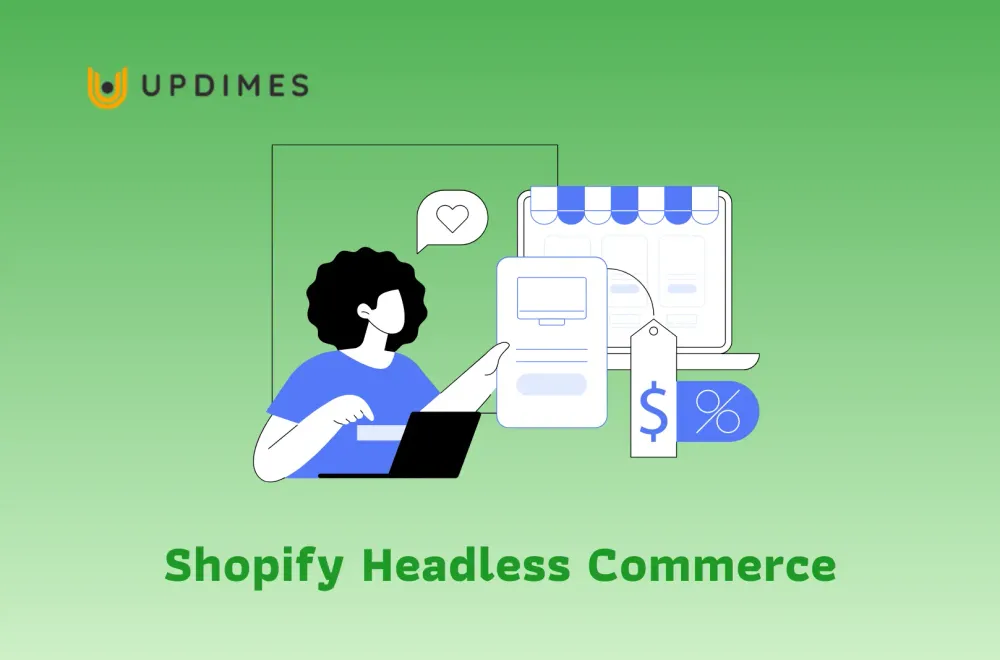Shopify Headless Commerce: An Ultimate Guide

As eCommerce continues to evolve, Shopify Headless Commerce emerges as a compelling solution for businesses looking to stay ahead of the curve. By decoupling the frontend presentation layer from the backend eCommerce functionalities, businesses can unleash a new realm of possibilities for customization, flexibility, and performance.
In this article, we delve into the concept of Shopify Headless Commerce, exploring its benefits, considerations, and real-world examples of merchants leveraging this approach to redefine their online stores.
What is Shopify Headless?
Shopify Headless is a method of using Shopify's backend (where you manage products, orders, etc.) without its frontend (the visual store interface). Instead, developers create custom frontend experiences using technologies like React, Vue.js, or Angular. This approach provides more flexibility and creativity in design and user experience, as developers have full control over the presentation layer. It's popular for creating unique, immersive online shopping experiences across various platforms like websites, mobile apps, or even in-store kiosks, while still leveraging Shopify's robust ecommerce functionalities like payments, inventory management, and order processing.
Benefits of Shopify Headless Commerce
Shopify Headless Commerce offers several benefits:
- Customized User Experience: Developers have complete control over the frontend, allowing them to create highly tailored, and unique user experiences that align with specific brand aesthetics and customer needs.
- Flexibility: With headless architecture, you can quickly adapt to rapidly changing market demands and experiment with new features or design elements without being limited by the constraints of a traditional eCommerce platform.
- Multi-Channel Selling: Headless commerce enables seamless integration with various channels and devices, including websites, mobile apps, social media platforms, and even IoT devices, providing customers with consistent experiences across all touchpoints.
- Performance: By decoupling the frontend and backend, headless architecture can improve website performance, loading times, and scalability, resulting in better user experiences and higher conversion rates.
- Scalability: Shopify's robust backend infrastructure handles tasks like inventory management, order processing, and payments, ensuring that the eCommerce store can scale efficiently to accommodate growing business needs.
- Third-Party Integrations: Businesses can leverage a wide range of third-party tools, services, and APIs to extend functionality and integrate with other systems, such as CRM software, marketing automation platforms, or analytics tools.
- Future-Proofing: Headless architecture provides a future-proof solution, enabling you to adapt to emerging technologies and consumer trends while maintaining a competitive edge in the rapidly evolving eCommerce landscape.
Shopify Headless Architecture
Shopify has been a pivotal force in empowering businesses to transition to a headless architecture, providing developers and merchants with a robust suite of tools tailored for headless commerce development. By leveraging Shopify's comprehensive set of headless development tools, businesses of all sizes can create bespoke, top-tier experiences efficiently and cost-effectively. The core of Shopify's headless solutions include 2 main elements:
- Storefront API, Shopify’s headless API layer
- Hydrogen and Oxygen, Shopify’s official development stack for headless commerce
Storefront API
What is Storefront API? Storefront API serves as the bedrock for headless commerce implementations. The Storefront API grants access to Shopify's full spectrum of commerce capabilities, including optimized cart functionality, dynamic product and collection pages, intuitive search and recommendation features, and contextual pricing tailored to individual buyer needs. This API-agnostic approach empowers developers to utilize their preferred frameworks, devices, and service platforms, fostering flexibility and innovation in the development process.
Hydrogen and Oxygen
Complementing the Storefront API is Shopify's official development stack comprising Hydrogen and Oxygen. Hydrogen, built on the React-based Remix framework, facilitates the creation of dynamic and high-performing headless commerce sites on Shopify. Its modular and commerce-optimized components, hooks, and utilities streamline development while ensuring speed, scalability, and maintainability. Furthermore, Oxygen, Shopify's globally-distributed hosting solution, simplifies deployment with its edge rendering capabilities and extensive network of points of presence worldwide. Included in all Shopify plans at no additional cost, Oxygen guarantees optimal performance and uptime while minimizing operational expenses for businesses.
With Shopify's headless solutions, developers and merchants have the flexibility to tailor their eCommerce experiences to meet specific business objectives, leveraging a composable stack of technologies to unlock new levels of innovation and competitiveness in the digital marketplace.
Shopify Headless Commerce: Pricing and Cost
The cost of a headless commerce project can vary significantly based on some factors such as functionality, customization level, integrations, and supporting tools. Here's a breakdown of potential costs:
- Upfront costs: For enterprise-level headless projects, depending on the complexity and scale of the project, the upfront costs could range from hundreds of thousands to millions of dollars. This includes expenses for frontend development, backend infrastructure, integrations, and customizations.
- Annual maintenance costs: In addition to upfront costs, businesses should budget for annual maintenance costs, which may include ongoing development, updates, support, and hosting fees.
- Additional channel costs: Building other channels on a headless platform, such as mobile apps, audio streams, or video game integrations, may have varying costs. For simpler implementations using app builders, costs could start as low as $99 a month.
- External agency fees: Businesses may need to hire external agencies or developers to assist with the build and implementation of the headless solution. These fees should be factored into the overall project budget.
- Subscription fees: Depending on the chosen technologies and tools, businesses may need to pay subscription fees for services like headless CMS platforms, third-party integrations, or cloud hosting providers.
- Customization and integration costs: The level of customization and integration with third-party systems can significantly impact costs. More complex customizations and integrations may require additional development resources and incur higher expenses.
It's essential for businesses to carefully evaluate their requirements, budget constraints, and long-term goals when considering a headless commerce approach. By thoroughly scoping out the project and accounting for all potential costs, businesses can make informed decisions and ensure successful implementation within their budgetary constraints.
5 Examples of Stores Powered by Shopify Headless Commerce
Nour Hammour
Nour Hammour, renowned for its premium outerwear, faced the challenge of translating its luxurious in-store experience to the digital realm. Understanding the importance of performance and customization, they turned to Shopify's headless solutions. By adopting Hydrogen for storefront development, they streamlined the process, leveraging prebuilt components like cart, pagination, and search, saving significant time and resources. The result was a visually stunning and fast-loading website that resembled an editorial lookbook, allowing customers to seamlessly navigate through campaign images and make purchases without leaving the context. Post-implementation, Nour Hammour witnessed remarkable results, including a 63% year-over-year increase in conversion rate and a staggering 128% year-over-year increase in sales, highlighting the efficacy of their headless approach.
Patta x Tommy
The collaboration between Patta and Tommy Hilfiger aimed to deliver a memorable digital experience rich in dynamic content, such as animation, HD video, and high-fidelity images. However, incorporating such content without compromising site performance posed a significant challenge. Recognizing the benefits of headless architecture, they opted for Shopify's Hydrogen framework. This decision allowed them to build the entire store functionality swiftly, dedicating the remaining time to crafting an immersive frontend experience. With Hydrogen's flexibility and efficiency, they achieved their goal, delivering a comprehensive and unforgettable digital storefront within a tight timeframe.
Solo Brands
Solo Brands, a conglomerate of outdoor and lifestyle brands, sought to consolidate its diverse portfolio under a unified digital architecture. Recognizing the need for flexibility, modularity, and performance, they turned to Shopify's headless solutions. By leveraging Shopify's high-performance web technologies, they tailored unique storefront experiences for each brand within the portfolio. For instance, Chubbies' storefront prioritized speed without compromising on product variety, while Isle Surf and Stand-Up Paddleboards focused on user-friendly updates for non-technical users. This strategic adoption of headless commerce enabled Solo Brands to streamline operations and deliver best-in-class experiences across its entire portfolio.
Drake Related
Drake Related, the digital hub for Drake's various ventures, aimed to create an innovative online experience mirroring Drake's iconic residence, "The Embassy." This ambitious project required a solution capable of recreating the essence of each project within an artistic rendition of Drake's house. Shopify's headless solutions emerged as the ideal choice, empowering the creative team to execute their vision effectively. By leveraging headless architecture, they recreated each project within the digital representation of Drake's house, providing customers with an immersive and visually captivating storefront experience. Additionally, Shopify's headless capabilities facilitated seamless integration with partner brands' back-office systems, automating inventory management and streamlining fulfillment processes.
These examples underscore the transformative impact of headless commerce, enabling Shopify merchants to deliver highly customized, performant, and memorable online experiences tailored to their unique brand identities and customer expectations.
Shopify Headless Commerce: FAQs
Can Shopify be used headless?
Yes, Shopify supports headless architecture, allowing developers to use custom frontend frameworks while accessing Shopify's backend functionality via APIs.
How much does Shopify headless cost?
The cost varies based on project complexity, but expenses include front-end development, hosting, and potential third-party integrations. Enterprise-level projects could cost hundreds of thousands to millions upfront, with ongoing maintenance costs.
Is Shopify headless free?
Shopify itself doesn't offer a free headless solution. Merchants incur costs for development and may need to subscribe to Shopify's pricing plans, depending on their needs.
What are the benefits of Shopify headless?
Benefits include customized user experiences, flexibility, multi-channel selling, improved performance, scalability, extensive third-party integrations, and future-proofing for emerging technologies.
Is headless commerce a fit for your business?
Determining if headless commerce fits your business, you need to comprehence your specific goals, resources, and challenges. Here are some factors to consider:
- Current infrastructure: If your business is thriving with a traditional architecture and integrating a new solution seems challenging, investing in headless commerce may not be necessary.
- Desire for personalization and flexibility: If you aim to deliver a more personalized and unique customer experience while having more development flexibility, headless commerce could be suitable.
- Development resources: Headless commerce requires development resources to support the transformation. It can be a viable option if you have the necessary resources available.
- Scenarios favoring Shopify headless commerce:
- Difficulty integrating new tools into existing infrastructure
- Slow development pace due to the inability to make simultaneous front- and back-end adjustments
- Desire for faster shopping experiences and more control over performance and site speed
- Vision for a unique shopping experience beyond current theme or template customizations
- Lack of a native mobile app or dissatisfaction with existing mobile shopping app usability
- Ambition to create unique storefront experiences not achievable with current platform limitations.
By assessing these factors and considering your business objectives, you can determine if headless commerce aligns with your needs and aspirations.
Final Words,
Shopify headless commerce is an innovative way for Shopify to enhance its online presence and deliver exceptional customer experiences. While the adoption of headless commerce requires careful consideration of resources and objectives, the potential rewards in terms of enhanced user experiences and business growth make it a worthy investment for forward-thinking eCommerce ventures.


